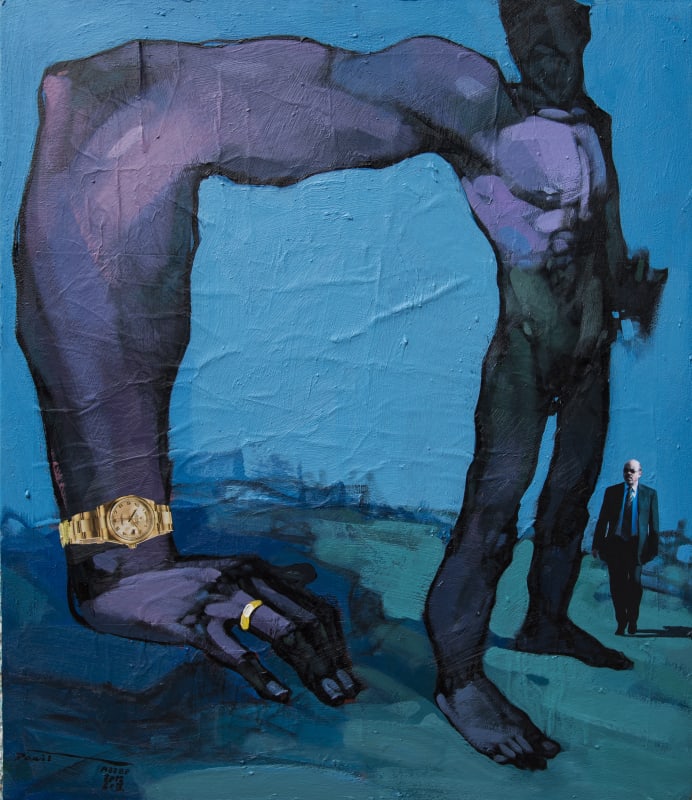PV: 13th February, 6:30-9pm
LONDON (LONDON BRIDGE)
ADDRESS
Kristin Hjellegjerde Gallery Ltd.
2 Melior Place
London
SE1 3SZ
+44 (0)20 3904 6349
Huge figures stand with their backs turned to the viewer as if trying to fade into the colourful painted backgrounds, alongside a collection of monstrous hands extending from muscular male bodies. These are the newest works by Ethiopian artist Dawit Abebe whose iconic large-scale faceless figures investigate how both individual and collective identities are constructed or obliterated based on the manipulation of history and the fabrication of new narratives by politicians. The accompanying series of paintings entitled ‘Long Hands’ continues these investigations through powerful new imagery. For his latest solo exhibition entitled EDIT at Kristin Hjellegjerde’s London Bridge Gallery, the artist brings together both these series to create a stunning visual exploration into how historical narratives are shaped, altered, absorbed and acted upon.
Over the last decade, Abebe’s focus has centred around storytelling and myth-making, specifically in relation to political power. ‘I try to reflect on how those of us who happen to be on the receiving end process, consume and act upon a narrative or an aspect of it formulated for us,’ commented the artist. His backward facing portraits offer a continuation of his 2017 exhibition Quo Vadis?, but whilst the earlier works showed only the back of the head and neck, these latest paintings depict expansive bare bodies; some with magnified insects hovering on them while others include images such as of a CD, a cassette or a mask. The presence of these elements adds a sense of unease to the overall images functioning as striking reminders of the environmental impact on human existence as well as the consequences of historical narratives. It is an unease that extends throughout the exhibition’s works, reflecting, according to the artist, his ‘frustrations, confusions, fear and uncertainty in relation to the current socio-political situations both at home and around the world’.
Abebe’s process begins with the artist covering the canvas with pages from old school exercise books - symbolising ‘acquired’ and ‘regulated’ knowledge - and then painting over the background, before incorporating his signature figures and other elements. Over time, the artist has developed a distinct visual vocabulary through which he is able to express complex ideas, using recurring motifs which are modified to suit each situation. The car plate, for example, was previously used as a geographical reference, whilst the numbers in the current works refer to significant events in Ethiopian history and read according to the country’s calendar, which is seven or eight years behind the Gregorian calendar depending on whether it is a leap year or not.
The ‘Long Hands’ series comprises ten smaller format paintings that revolve around the Ethiopian expression of “having long hands” (ረጅም እጆች) which refers to power exercised in various forms by the few while affecting the lives of many. Each of these works depict a naked male form with one oversized long arm bent into a pose of dominance across the canvas. In several of the paintings, the hand is shown pressing down into the ground as if suppressing the earth and on each wrist there’s a shiny watch. Interestingly, the watch is the most ‘realistically’ rendered object in these surreal scenes, simultaneously drawing the viewer’s attention to its presence and offering a comment on the obscenity of wealth. In a similar way, the paintings feature collage cut-outs of small figures as representative of contemporary culture - including religious and political leaders as well as famous and ordinary figures - in contrast to the mythical presence of the ‘long-armed man’. The juxtaposed artistic styles symbolise the conflation of time in the artist’s work, whilst also emphasising the lasting power that narratives can hold and how they can impact an individual as well as a collective identity with detrimental consequences.
‘My aim is to open a dialogue for us to scrutinize what happens to the existence of those who ‘consume’ and ‘act upon’ such maneuvered stories,’ says the artist. In this way, Abebe invites viewers to consider the ‘editing’ of history, to examine not just how stories are told, but for what purpose, and to recognise how they might influence one’s perspectives.


